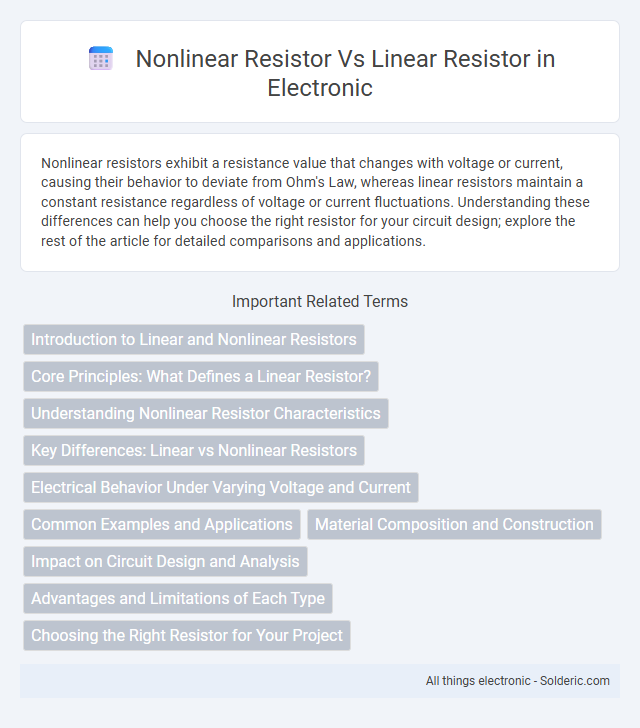Nonlinear resistors exhibit a resistance value that changes with voltage or current, causing their behavior to deviate from Ohm's Law, whereas linear resistors maintain a constant resistance regardless of voltage or current fluctuations. Understanding these differences can help you choose the right resistor for your circuit design; explore the rest of the article for detailed comparisons and applications.
Comparison Table
| Feature | Nonlinear Resistor | Linear Resistor |
|---|---|---|
| Voltage-Current Relationship | Nonlinear (does not follow Ohm's Law) | Linear (follows Ohm's Law) |
| Resistance | Varies with voltage or current | Constant |
| Examples | Diode, Varistor, Thermistor | Cylindrical Carbon Resistor, Film Resistor |
| Applications | Voltage regulation, surge protection, temperature sensing | Current limiting, voltage division, signal conditioning |
| Symbol | Varies by device type | Standard resistor symbol |
| Power Dissipation | Varies, often nonlinear | Linear, predictable |
| Behavior Under Load | Non-proportional | Proportional |
Introduction to Linear and Nonlinear Resistors
Linear resistors maintain a constant resistance regardless of voltage or current changes, resulting in a proportional, predictable voltage-current relationship defined by Ohm's law. Nonlinear resistors exhibit a variable resistance that changes with applied voltage, current, or temperature, leading to a nonlinear, often complex voltage-current characteristic curve. Devices such as thermistors, varistors, and diodes represent nonlinear resistors widely used for voltage regulation, surge protection, and temperature sensing applications.
Core Principles: What Defines a Linear Resistor?
A linear resistor follows Ohm's Law, where the voltage across it is directly proportional to the current flowing through it, resulting in a constant resistance value regardless of voltage or current changes. Nonlinear resistors, in contrast, have resistance values that vary with applied voltage, current, temperature, or other environmental factors, causing non-proportional voltage-current relationships. The core principle defining a linear resistor is this predictable, constant resistance that produces a straight-line V-I characteristic on a graph.
Understanding Nonlinear Resistor Characteristics
Nonlinear resistors exhibit voltage-current relationships that deviate from Ohm's law, causing their resistance to change with voltage or current variations, unlike linear resistors which maintain constant resistance regardless of applied voltage. Key characteristics of nonlinear resistors include their nonlinear V-I curves and dependence on factors such as temperature, voltage thresholds, or frequency, often utilized in applications like voltage regulation and signal modulation. Understanding these unique attributes enables effective design choices in circuits requiring variable resistance behavior or protection from overcurrent conditions.
Key Differences: Linear vs Nonlinear Resistors
Linear resistors maintain a constant resistance regardless of the voltage or current applied, following Ohm's Law with a direct proportionality between voltage and current. Nonlinear resistors exhibit a resistance that changes with voltage, current, or temperature, resulting in a nonlinear current-voltage characteristic curve. Understanding these key differences helps you select the appropriate resistor type for applications requiring stable resistance or variable response under specific electrical conditions.
Electrical Behavior Under Varying Voltage and Current
Nonlinear resistors exhibit a variable resistance that changes with applied voltage and current, causing their current-voltage (I-V) characteristics to form curved plots rather than straight lines. Linear resistors maintain a constant resistance regardless of voltage or current, resulting in a directly proportional, linear I-V relationship described by Ohm's Law. Devices like varistors and diodes are common nonlinear resistors used for voltage regulation and protection, while fixed-value resistors function linearly in most electronic circuits.
Common Examples and Applications
Nonlinear resistors, such as varistors and diodes, exhibit voltage-dependent resistance and are commonly used for surge protection and signal modulation in electronic circuits. Linear resistors, including carbon film and metal oxide variants, maintain a constant resistance regardless of voltage and are widely applied for current limiting and voltage division. Understanding the distinct behaviors helps you select appropriate components for stable circuit performance or adaptive response.
Material Composition and Construction
Nonlinear resistors typically use semiconductor or metal oxide materials whose resistance changes with voltage or temperature, such as varistors made from zinc oxide. Linear resistors are often constructed from carbon film, metal film, or wire wound materials designed to provide a stable and predictable resistance regardless of applied voltage or environmental conditions. The internal structure of nonlinear resistors incorporates grain boundaries or junctions that enable their variable resistance properties, while linear resistors feature uniform resistive elements ensuring constant resistance values.
Impact on Circuit Design and Analysis
Nonlinear resistors introduce variable resistance depending on voltage or current, complicating circuit design due to their unpredictable behavior compared to linear resistors with constant resistance. Your circuit analysis must incorporate advanced techniques like numerical methods or piecewise linear models to accurately predict performance when nonlinear resistors are involved. This impacts stability, frequency response, and overall predictability, requiring specialized simulation tools for effective design and optimization.
Advantages and Limitations of Each Type
Nonlinear resistors offer advantages such as voltage-dependent resistance, enabling applications in voltage regulation, surge protection, and signal modulation, but they can introduce complexity and non-ideal behaviors in circuits. Linear resistors provide predictable and stable resistance values, making them ideal for precise current control and voltage division, yet they lack adaptability to varying electrical conditions. Your choice between nonlinear and linear resistors depends on the specific application requirements, balancing simplicity against functionality.
Choosing the Right Resistor for Your Project
Selecting the appropriate resistor is crucial for project performance; nonlinear resistors like varistors and thermistors adjust resistance based on voltage or temperature, ideal for surge protection and temperature sensing applications. Linear resistors maintain a constant resistance regardless of voltage or current, making them suitable for stable voltage regulation and current limiting in circuits. Evaluating the specific electrical behavior and environmental conditions of your project ensures optimal resistor choice for efficiency and reliability.
Nonlinear resistor vs linear resistor Infographic

 solderic.com
solderic.com